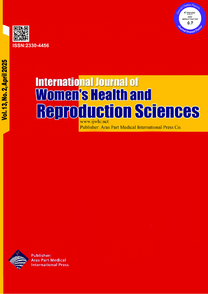| Original Article | |
| First Trimester Bleeding and Pregnancy Outcomes: Case-Control Study | |
| Betül Yakıştıran, Tuncay Yüce, Feride Söylemez | |
| Department of Obstetric and Gynecology, Ankara University, Ankara, Turkey | |
|
IJWHR 2016; 4: 004-007 DOI: 10.15296/ijwhr.2016.02 Viewed : 5559 times Downloaded : 11481 times. Keywords : Abortion, Uterine hemorrhage, Perinatal outcomes, Preterm labor |
|
| Full Text(PDF) | Related Articles | |
| Abstract | |
Objectives: The purpose of this study was to determine the perinatal outcome and pregnancy complication (preterm delivery, preterm prelabour rupture of membrane [PPROM], preeclampsia, placental abruption and intrauterine growth restriction [IUGR]) of threatened miscarriage. Materials and Methods: A total of 963 patients attended the study. Of these, 493 women had threatened miscarriage. The control group included 470 pregnants without first trimester vaginal bleeding. We compared the two groups according to maternal age, gravida, parity, spontaneous or induced abortion history, pregnancy period, livebirth or pregnancy loss, newborn weight and Apgar values after 1 and 5 minutes, newborns? gender for livebirth and preterm deliveries. Results: Incidence of preterm delivery, abortion, lower gestational fetal weight and preterm rupture of membrane was increased in threatened miscarriage group. Mean pregnancy period in threatened miscarriage group was 243 days; in control group was 263 days. There was adverse influence of maternal age and abortion history on outcomes in pregnancies with threatened miscarriage. However sex of the fetuses and Apgar values after 1 and 5 minutes were similar between two groups. Conclusion: Threatened miscarriage is an important situation to predict both the maternal and fetal outcomes in late pregnancy. Maternal obstetric history on previous pregnancies should be questioned. It is therefore essential to consider these pregnancies as high risk group and provide careful antenatal care. |
Cite By, Google Scholar
Online Submission System
 IJWHR ENDNOTE ® Style
IJWHR ENDNOTE ® Style
 Tutorials
Tutorials
 Publication Charge
Women's Reproductive Health Research Center
About Journal
Publication Charge
Women's Reproductive Health Research Center
About Journal
Aras Part Medical International Press Editor-in-Chief
Arash Khaki
Mertihan Kurdoglu Deputy Editor
Zafer Akan























